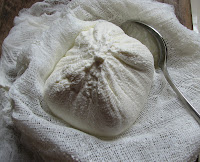 |
| Labneh, made with whole-milk yogurt. |
Labneh is probably the easiest cheese to make at home: two ingredients and minimal equipment. For comparison sake, I made one batch using non-fat yogurt and a second batch with full-fat yogurt. The full-fat yogurt naturally produced a firmer, richer cheese, but even the non-fat yogurt had decent results (plus, no fat!). Whatever type of yogurt you choose, get a high-quality one that does not contain gelatin, pectin, or stabilizers, as any additives will affect how the yogurt drains.
Labneh
Ingredients and Tools
1 quart plain yogurt
1/2 tsp. kosher salt
A deep bowl
Fine-mesh sieve
Cheesecloth or muslin
Kitchen twine
Method
Place the sieve on top of your bowl. Fold a large square of cheesecloth into quarters and set it inside the sieve, or substitute a piece of muslin for the cheesecloth.
Mix the salt into the yogurt, and pour the mixture into the cheesecloth. Let it drain for about 10 minutes, then bring the ends of the cheesecloth together to form a bundle of yogurt. Tie the bundle with kitchen twine.
Leave the bundle in the sieve, or tie it to a wooden chopstick and place the chopstick across the top of the bowl so the bundle is suspended. Let the yogurt drain, refrigerated, for 12 to 24 hours. The longer it drains, the thicker the final product will be. Keep an eye on the level of the liquid (whey) that's collecting in the bowl, and make sure it never reaches the bottom of the bundle or sieve. You can save the whey for cooking or baking, or discard. I found it easier to suspend the bundle after the yogurt had drained for a couple of hours and had compacted somewhat, so the bundle didn't hang as low in the bowl.
When the yogurt has drained sufficiently, untie the bundle, remove the cheesecloth, and transfer the cheese to a serving dish or container. Refrigerate leftovers.

No comments:
Post a Comment